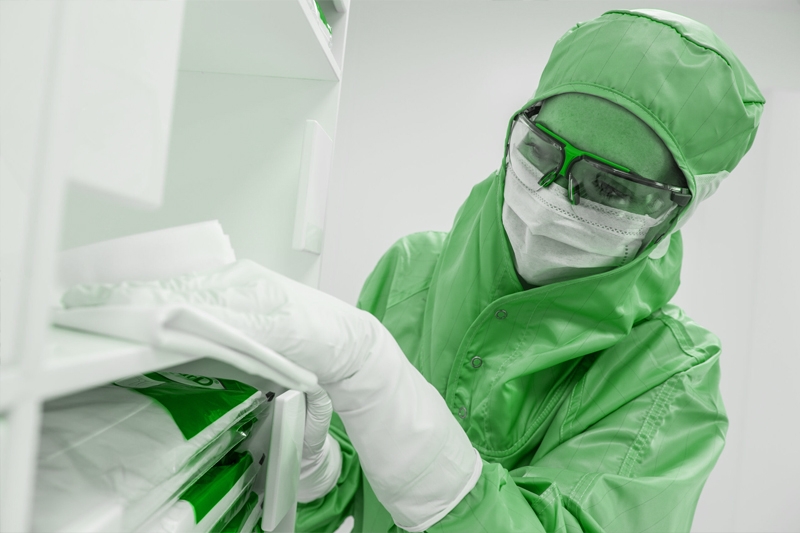1. Cleanroom design elements that make the cleanroom clean:
Cleanroom use HEPA filtration to remove particulates from the air. HEPA is “an acronym for "High Efficiency Particulate Air [filter]" (as officially defined by the U.S. Dept. of Energy). This type of air filter can theoretically remove at least 99.97% of dust, pollen, mold, bacteria, and any airborne particles with a size of 0.3 microns (µm).” HEPA fan filter units have fan attached to HEPA filter assembly to push the air thru the filter. The HEPA fan filter units are placed in ceiling of cleanroom so the only air entering the cleanroom is clean air thru the HEPA fan filter units.
Higher class cleanrooms can also use ULPA filters. ULPA stands for Ultra Low Particulate Air. ULPA filters are denser than HEPA filters, so they are 99.999% effective at removing particulates 0.12-micron diameter or larger. The HEPA fan filter units are placed in ceiling of cleanroom so the only air entering the cleanroom is clean air thru the HEPA fan filter units.
Cleanroom have Air lock/Gown room to prevent particles from entering the cleanroom every time the door is opened. The airlock prevents 96% of particulates from entering the cleanroom. The room also provides a clean space for personnel to put on their cleanroom garments – which also stops particles from entering the cleanroom.
Only non-particulating materials used for cleanroom construction
- Modular cleanroom walls have Melamine, vinyl, FRP, or painted aluminum surfaces. Standard construction gypboard walls must be painted with epoxy paint.
- Only special vinyl coated cleanroom ceiling tiles are used in cleanroom ceilings. Standard commercial ceiling tiles will particulate.
- Special sealed lights are used in cleanrooms to keep particulates from leaking into cleanroom from plenum.
- Cleanrooms have special flooring requirements. Not only must the flooring be non-particulating, but it must be easily cleanable and durable since in medical device and pharmaceutical cleanrooms it is subject to frequent cleaning with harsh cleaning agents. Acceptable flooring materials include Industrial VCT, epoxy, heat welded vinyl, heat welded vinyl with integral cove. The type of flooring selected depends on cleanroom classification, industry of user and expected cleaning regimen.
- Some cleanrooms use Air showers as last step before personnel enter cleanroom. The purpose of the air shower it to blow off any particulates on the outside of personnel cleanroom garments with HEPA filtered super clean air.
2. Cleanroom personnel rules to prevent them from introducing particulates into the cleanroom. These include:
- Always wear cleanroom garments when inside cleanroom
- No eating or drinking in cleanroom
- Cleanroom doors always kept closed after entering cleanroom
- Wipe down all cleanroom surfaces on regular basis
- Wipe down all equipment before bringing into cleanroom
- Do not bring cardboard or other particulating material into cleanroom.
3. Cleanrooms must be cleaned on a regular basis to keep them clean.
Daily or weekly cleaning is done to remove an particulates that may have settled on walls, work surfaces or floor.
Industrial cleanroom are typically wiped Isopropyl wipes or Simple Green.
Pharmaceutical and medical device cleanrooms often use more aggressive cleaning agents like bleach, spore-clean, De-ton, perchloric acid to attack microbial or mold contamination.
4. Regular Cleanroom Testing
Cleanroom are typically tested internally weekly or monthly with annual 3rd party testing. The cleanroom is tested to ensure it meets the ISO 14644-1 cleanroom classification. Viable testing is also done to ensure cleanroom meets sterility requirements. Regular testing is an important part of keeping a cleanroom clean. Testing will show if there are contamination problem and allow the cleanroom user to address the problem.
A. For cleanroom classification - the test is for non-viable particles. For ISO 14644-1 each cleanroom classification has a maximum number of particles of a certain size per cubic meter. These measurements are taken using a laser particle counter
B. Cleanroom viable testing is for live organisms. Typically, samples are collected using settling plates with some type of media. The plates are placed in the cleanroom at specific locations for 4 hours and then are then sent off to analytical labs for incubation and measurement.
Conclusion
The science of making cleanrooms include using HEPA filtration, non-particulating materials, airlocks, and non-particulating flooring. In addition, cleanroom personnel follow special rules such as wearing cleanroom garments, no eating or drinking, and wipe down the cleanroom on regular basis. Finally, it is important monitor the cleanliness of the room using particle testing and biological settling plates to identify problems and address them.











